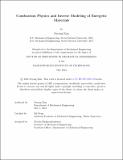| dc.contributor.advisor | Deng, Sili | |
| dc.contributor.author | Kim, Suyong | |
| dc.date.accessioned | 2025-08-27T14:30:34Z | |
| dc.date.available | 2025-08-27T14:30:34Z | |
| dc.date.issued | 2024-05 | |
| dc.date.submitted | 2024-06-13T16:43:51.956Z | |
| dc.identifier.uri | https://hdl.handle.net/1721.1/162511 | |
| dc.description.abstract | Energetic material combustion involves intricate multi-scale and multi-phase dynamics, where the interplay of chemical reaction and transport processes results in complex wave patterns across a wide range of length scales from nano to millimeter. Our limited fundamental understanding of these combustion processes poses a challenge to design and optimize combustion properties, leading to significant reliance on empirical knowledge. Deeper comprehension can be achieved by linking fundamental aspects of reaction and transport to combustion dynamics. However, there are very limited diagnostic tools available to quantify material properties and chemical kinetics for heterogeneous materials under combustion, which hinders the quantitative analysis of combustion waves. Furthermore, combustion wave dynamics and flame structures in modern nanocomposite energetic materials have not been fully resolved. This lack of breath in modeling techniques and experimental characterization has prevented quantitative analysis of combustion wave dynamics for energetic materials.
This thesis aims to establish theories for combustion waves in energetic materials by correlating their intrinsic chemical reaction and transport properties with wave dynamics. To achieve this goal, two major steps are involved. First, we propose a novel inverse modeling approach to infer material properties and chemical kinetics using PDE-constrained optimization, which allows for deciphering the reaction-transport coupling from observable dynamics in currently available combustion diagnostic tools. We further discuss training challenges of neural differential equations with data subject to scale separation and propose mitigation strategies that enable learning stiff dynamical systems. Secondly, we investigate flame structures and dynamics in nanocomposite energetic materials at length scale ranging from micron to sub-millimeter using high-speed microscopic imaging techniques. Two distinct combustion wave patterns are characterized by flame dynamics and stability. Based on inverse modeling and microscopic observation, we finally construct two theories of combustion wave propagation and wave stability, by performing scaling analysis on wave dynamics in terms of mass and thermal transports and chemical reaction. A systematic view of energetic material combustion allows for deeper comprehension of how multi-scale dynamics of reaction and transports evolve in macro-scale combustion waves, potentially leading to the development of predictive models for the intricate heterogeneous combustion dynamics of energetic materials. | |
| dc.publisher | Massachusetts Institute of Technology | |
| dc.rights | Attribution-NonCommercial-NoDerivatives 4.0 International (CC BY-NC-ND 4.0) | |
| dc.rights | Copyright retained by author(s) | |
| dc.rights.uri | https://creativecommons.org/licenses/by-nc-nd/4.0/ | |
| dc.title | Combustion Physics and Inverse Modeling of Energetic Materials | |
| dc.type | Thesis | |
| dc.description.degree | Ph.D. | |
| dc.contributor.department | Massachusetts Institute of Technology. Department of Mechanical Engineering | |
| dc.identifier.orcid | https://orcid.org/0000-0002-7999-1147 | |
| mit.thesis.degree | Doctoral | |
| thesis.degree.name | Doctor of Philosophy | |
